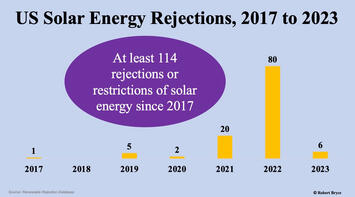
Last Tuesday during his State of The Union speech, President Joe Biden repeated a claim he has made many times over the past few years about renewable energy. Biden declared that the Inflation Reduction Act is “the most significant investment ever in climate change, ever. Lowering utility bills, creating American jobs, leading the world to a clean energy future.”
In 2020, while campaigning for the White House, Biden released an energy plan that promised to “spur the installation of millions of solar panels, including utility-scale, rooftop, and community solar systems.”
In 2021, Biden’s White House released a plan which claimed the U.S. could be getting nearly half of its electricity from solar by 2050. The plan was released a few days after Biden declared we need to overhaul our energy and power systems because climate change poses “an existential threat to our lives.”
Last July, the Biden administration touted its Community Solar Subscription Platform which aims to “connect families to solar energy and lower electricity bills through the Low-Income Home Energy Assistance Program (LIHEAP) and other low-income assistance programs.” The effort was designed to “jump-start solar energy careers in underserved communities. Today’s announcements support President Biden’s goal to reach a carbon-free electricity sector by 2035 while creating good-paying jobs across the country.”
But those breezy claims about solar, jobs, and a carbon-free grid, keep crashing into the hard realities of land use and local politics. On Wednesday, roughly 24 hours after Biden gave his State of the Union speech, the Zoning Hearing Board in Scranton Joe’s hometown, vetoed a proposed 4.3-megawatt solar project. Here’s how Jim Lockwood of Scranton’s Times-Tribune, reported on the hearing:
- The zoning board on Wednesday rejected a proposal for a solar farm on West Mountain after some neighbors expressed opposition to the plan. Massachusetts-based ECA Solar sought zoning approval to build a large-scale solar array with 12,000 panels on a 73-acre tract on West Mountain in the rear 800 block of North Keyser Avenue off Graham Street. The board voted 4-1...to reject a special exception that ECA needed to advance the plan. The ECA project, called Electric City Solar Initiative, would be the first commercial solar venture in the city. It would cost nearly $9 million to construct and produce 4.35 megawatts of electricity.
- The array would contain three sections of panels situated on 36 acres of the 73-acre tract and within buffered areas…the tract formerly hosted coal mining many years ago and ECA Solar bought the land in 2021 because it's near PPL electrical facilities.
The site of the proposed solar project is about four miles west of the house on North Washington Avenue that Biden lived in as a child. Lockwood explained that Scranton residents raised “various issues and concerns about the solar project.” His article continued:
- Keyser Valley Citizens Association Vice President Bridget Chomko, who said she represented Fawnwood and Keyser Valley residents, spoke about potential negative impacts of stormwater runoff and said the neighborhood's quality of life would forever be altered by a solar farm. Residents now have woods and wildlife next door, but if the solar farm is allowed, such an "idyllic view" of Fawnwood "would transform to an eyesore of the metal and the glass of the solar panels," Chomko said.
- Resident Brian Gallagher also believes the solar farm would only benefit ECA and there would not be any upside for the neighborhood and city. "I think the biggest concern is there is no benefit" to the neighborhood or city, Gallagher said. "Nobody wants to look at them."
The rejection of the solar project in Scranton provides yet more proof that land-use conflicts are slowing or stopping the growth of renewable energy projects all across America. As can be seen in the newly updated Renewable Rejection Database (which is now searchable by keyword, year, and state) the rejection of ECA’s project is the sixth solar rejection of 2023. It also marks the 114th rejection of solar in the U.S. since 2017.
Read the rest of this piece at Robert Bryce Substack.
Robert Bryce is a Texas-based author, journalist, film producer, and podcaster. His articles have appeared in a myriad of publications including the Wall Street Journal, New York Times, Forbes, Time, Austin Chronicle, and Sydney Morning Herald.
Graph: courtesy Robert Bryce Substack












